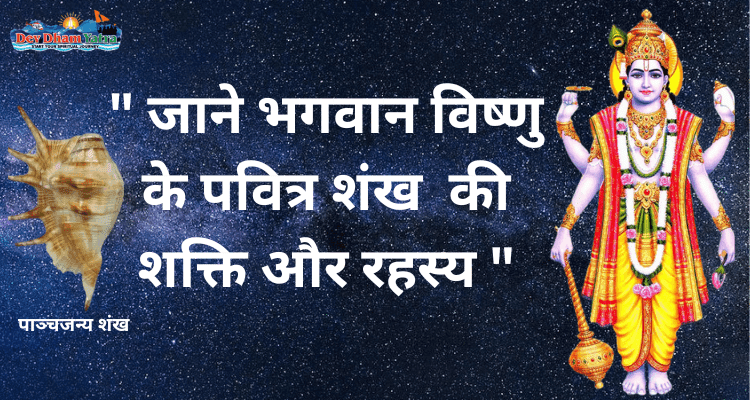The spiritual significance of Vishnu Panchajanya Shankh
In Hinduism, the Shankh is considered a sacred and auspicious symbol with significant spiritual and religious significance. It is believed to have been created by Lord Vishnu and has been associated with him since ancient times.
The blowing of the Shankh is considered an important ritual in Hinduism and is often performed during religious ceremonies, puja (worship), and other auspicious occasions such as weddings, housewarming ceremonies, and other auspicious events. It is believed that the sound of the Shankh has the power to purify the environment and invoke the blessings of the gods.
In Hinduism, the Shankh is also used as a symbol of victory and is often depicted as being held by Lord Vishnu and other gods. The right-spiraled white shankh is considered especially sacred and is said to symbolize the goddess Lakshmi, the goddess of wealth, prosperity, and good fortune.
In addition, the Shankh is also associated with the Hindu god Shiva, who is said to have used it to destroy the city of Tripura. The Shankh is also an important part of Hindu mythology and is mentioned in various Hindu scriptures, including the Puranas and the Mahabharata.
Importance of Shankh in hindu mythology
Lord Vishnu is one of the most important gods in Hinduism and is considered the preserver of the universe. He is often depicted holding a shankh , which is an important symbol in Hindu mythology.
The story of Lord Vishnu Shankh is associated with the “Samudra Manthan” or “Churning of the Ocean.” According to Hindu mythology, the gods and demons worked together to churn to the ocean in search of the nectar of immortality. During the process, several powerful and dangerous objects emerged from the ocean, including the deadly poison “Halahala.” To save the world from destruction, Lord Vishnu took the form of a turtle and used his shell to support the mount Mandara, which was used as the churning rod, while demons and gods pulled on the serpent Vasuki, who was used as the churning rope.
As the ocean was being churned, Lord Vishnu blew into his Shankh to create a powerful sound, which had the power to calm the violent churning of the ocean and control the dangerous objects that emerged. The Shankh also became a source of inspiration and comfort to the gods and demons, who were tired from the arduous task of churning the ocean.
The Shankh is considered a symbol of Lord Vishnu’s power and is also used in Hindu rituals and ceremonies to create a divine atmosphere and invoke the blessings of the Lord. It is believed that the sound of the Shankh symbolizes the cosmic sound of creation and has the power to purify the mind and body of the listener.
In conclusion, the Shankh is an important symbol in Hindu mythology and is considered an embodiment of Lord Vishnu’s power and presence.
Type of Shankh
There are several types of Shankh that are used in Hinduism each with its own unique shape, size, and sound. Some of the most common types of Shankh are:
1.Panchajanya Shankh
The Panchajanya is one of the divine shankh in Hindu mythology and is associated with Lord Vishnu. It is mentioned in the ancient Hindu texts, the Vedas and the Puranas, and is considered to be one of the most sacred and powerful objects in Hinduism.
The Panchajanya is said to have been given to Lord Krishna (an incarnation of Lord Vishnu) by the great serpent, Shesha, and was used by Krishna to blow a powerful blast to signal the start of the battle of Kurukshetra. The sound of the Panchajanya is said to be so powerful that it can awaken the dead and bring the gods down to earth.
In Hindu mythology, the Panchajanya is also considered to be an important symbol of truth, righteousness, and good governance. It is said that the sound of the shankh represents the “om” or the primordial sound that pervades the universe, and is considered to be a call to all living beings to come together and live in harmony.
The Panchajanya is also an important part of Hindu religious ceremonies and is blown during puja (worship) and other religious rituals. The use of the shankh in Hinduism is a way of invoking the presence of the divine and reminding the devotee of the power of the gods.
2.Vamavarti Shankh
Vamavarti Shankh is considered sacred in Hinduism and is used for religious purposes. It is commonly used during Hindu rituals and ceremonies, including weddings, pujas, and yagnas. The Vamavarti Shankh is considered to be the left-turning shankh, as opposed to the right-turning shankh, which is known as dakshinavarti shankh. In Hindu mythology, the sound of the vamavarti shankh is said to represent the divine sound of creation and is believed to have a purifying effect on the environment.
3.Gaumukhi Shankh or Panchmukhi shankh
Gaumukhi Shankh or Panchmukhi shankh, also known as the Cow’s Mouth Conch, is a type of conch shell that is used for religious purposes. The Gaumukhi Shankh is considered to be sacred and is often blown during puja (worship) rituals and other religious ceremonies. It is also believed to have spiritual and healing properties and is used for purifying the environment and for invoking the blessings of the divine. The Gaumukhi Shankh is typically held in the right hand and is blown three times to represent the Hindu trinity of Brahma, Vishnu, and Mahesh.
4.Ganesha Shankh
Ganesha Shankh is associated with Lord Ganesha. Ganesha is the god of wisdom, prosperity, and new beginnings, and the Ganesha Shankh is believed to symbolize his qualities and bring good luck and success to those who use it. In Hindu rituals, the Ganesha Shankh is often blown to invoke the blessings of Lord Ganesha and to create a positive and auspicious atmosphere.
5.Kauri Shankh
Kauri Shankh is believed to be the Lord Vishnu shankh , one of the main deities in Hinduism, and is often blown during religious ceremonies and rituals. The Kauri Shankh is also believed to have healing properties and is used for medicinal purposes in traditional Ayurveda. In Hindu culture, the Kauri Shankh is seen as an auspicious object and is often gifted to friends and family members during festivals and special occasions.
6.Moti Shankh
Moti Shankh is used in various rituals. “Moti” means “pearl” in Hindi, and the name refers to the white, lustrous appearance of the shell. Moti Shankh is believed to bring prosperity and good luck to the owner, and it is also considered to have powerful healing properties. In Hindu mythology, it is associated with Lord Vishnu shankh and is used for religious purposes, such as for blowing during a puja (worship ceremony) or for keeping in the home as a symbol of auspiciousness. Moti Shankh is also used in Ayurvedic medicine, where it is believed to have the ability to cure various illnesses and promote overall well-being.
7.Heera Shankh
Heera Shankh is considered sacred in Hinduism. “Heera” means “diamond” in Hindi, and the name refers to the rare and precious nature of the shankh. In Hindu mythology, Heera Shankh is associated with Lord Vishnu shankh and is believed to bring prosperity, good luck, and success to the owner. It is also considered to have powerful healing properties and is used for medicinal purposes in traditional Ayurvedic medicine. Heera Shankh is often used during religious ceremonies and rituals, such as for blowing during a puja (worship ceremony) or for keeping in the home as a symbol of auspiciousness. Overall, Heera Shankh is highly valued and revered in Hindu culture, and owning one is seen as a great blessing.
8.Dakshinavarti Shankh
This is a rare and highly prized type of Shankh that spirals to the right and is considered to be particularly auspicious. It is believed to bring prosperity, good luck, and success.
9.Lakshmi Shankh
This type of Shankh is named after the Hindu goddess of wealth and prosperity and is considered to bring good luck and financial success.
Interesting facts about Shankh:
Shankh is commonly found in the Indian Ocean and the Pacific Ocean. The right-handed Shankh is considered more sacred and is used more frequently in Hindu rituals and ceremonies.
- The sound of the Shankh is believed to purify the environment and dispel negative energy.
- In Hindu weddings, the Shankh is blown to symbolize the union of the bride and groom and to invite the gods to bless the union
- The Shankh is also used in Ayurvedic medicine as a remedy for respiratory and digestive problems, as well as for reducing stress and promoting peace of mind.
- The Shankh is often carved with intricate designs and decorated with precious stones, making it a popular collector’s item.
- There are many different types of Shankh, each with its own unique shape, size, and sound.
The scientific significance of Shankh
In addition to its religious and cultural significance, the Shankh also has a scientific significance. Here are a few ways in which the Shankh is significant from a scientific perspective:
Acoustics
The shape and size of the Shankh make it a perfect musical instrument. When blown, the Shankh produces a deep, resonant sound that is believed to have therapeutic effects on the mind and body. Scientists have found that the sound of the Shankh can have a calming effect on the nervous system and can help to reduce stress and anxiety.
Marine Biology
The Shankh is a type of sea snail, also known as a gastropod, and is found in the ocean. The study of the Shankh and other sea snails is important for understanding the biology and ecology of the ocean and the evolution of life on Earth.
Archaeology
The Shankh is a commonly found artifact in archaeological sites and is considered an important source of information about ancient cultures and civilizations. The study of ancient Shankhs can provide valuable information about trade, commerce, and cultural exchange in the past.




















